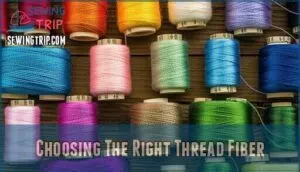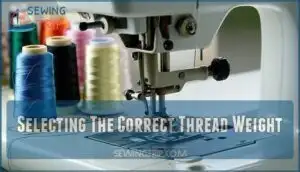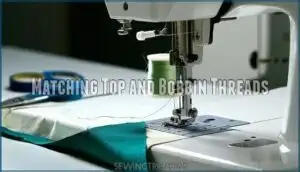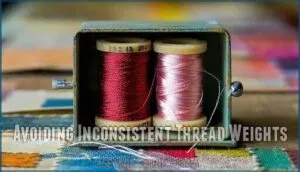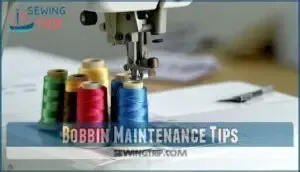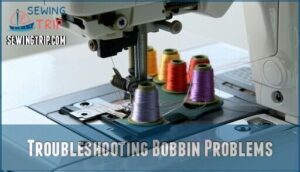This site is supported by our readers. We may earn a commission, at no cost to you, if you purchase through links.
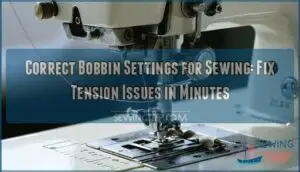 You’ll get perfect stitches when your bobbin tension balances with your top thread.
You’ll get perfect stitches when your bobbin tension balances with your top thread.
Set your upper tension to 3-4 for medium-weight fabrics and cotton thread.
Your bobbin should feel slightly looser than the top thread when you pull it.
Test on fabric scraps first – good stitches look identical on both sides without puckering or visible bobbin thread showing through.
Make small quarter-turn adjustments to your bobbincase tension screw until everything clicks.
Different threads and fabrics need tweaks, but nailing these correct bobbins settings for sewing basics solves most frustration.
Once you master the tension dance, even tricky projects become surprisingly manageable, and you’ll achieve perfect stitches with the right balance of top thread.
Table Of Contents
Key Takeaways
- Set your bobbin tension between 18-25 grams of pull force and upper tension to 3-4 for medium-weight fabrics – test on scraps first to ensure stitches look identical on both sides without puckering.
- Match your top and bobbin thread weights exactly (like 40wt on both) to prevent tension imbalances, thread bunching, and uneven stitches that occur when using mismatched threads.
- Wind bobbins fresh before each project at medium speed, filling only to 90% capacity to avoid thread crossing, memory issues, and jams that pre-wound bobbins often cause.
- Clean your bobbin area every 8-10 hours of use with small brushes to remove lint buildup, and always use the correct bobbin class for your machine to prevent wobbling and feeding problems.
Ideal Bobbin Tension
You’ll need to set your bobbin tension between 18 to 25 grams of pull force for most general sewing projects.
This range prevents common problems like uneven stitches and thread bunching that can ruin your work.
General Sewing Tension Settings
Your machine’s tension sweet spot typically falls between 18 to 25 grams of pull force for most fabrics.
Start with factory settings, then make test stitches on scrap fabric to check stitch appearance.
Adjust the bobbin case screw gradually if you notice uneven loops or thread bunching, as balanced tension creates consistent stitching across different fabric thickness levels.
Solving common sewing problems through proper tension troubleshooting is crucial for achieving optimal results.
Thread Type and Weight Considerations
Thread compatibility directly affects bobbin tension settings across different fabric types.
When you match your bobbin thread’s fiber properties and weight to your top thread, you’ll achieve balanced tension without constant adjustments.
Weight effects become noticeable when using heavy threads with lightweight bobbins, creating uneven stitches.
Thread strength varies between material blends, requiring specific tension settings for superior performance.
Understanding thread fiber and weight is essential for proper bobbin tension and to achieve balanced tension without constant adjustments, considering the impact of thread strength.
Adjusting Tension for Specialty Threads
Specialty threads need different tension settings than standard thread. Each thread type behaves differently, requiring adjustments for best results. Test on fabric scraps before starting your project.
A clean bobbin case is essential for maintaining proper tension.
Adjusting bobbin tension for specialty threads:
- Metallic threads – Loosen tension slightly to prevent breakage and maintain shine
- Elastic threads – Reduce tension by half-turn counterclockwise for proper shirring
- Heavy-duty threads – Decrease tension in small increments to allow smooth feeding
- Delicate fabric threads – Increase tension slightly to prevent loose stitches
Using Tension Gauges for Accuracy
Professional tension gauges eliminate guesswork with precise measurements between 180-220gf for ideal bobbins settings.
You’ll achieve consistent readings through proper gauge calibration and advanced techniques.
These expert tips guarantee accurate tension adjustment: thread the bobbin case correctly, pull steadily for reliable measurements, and record values for different thread types.
Quality gauges provide the control needed for professional stitch quality.
It’s important to use a gauge to measure the bobbin thread tension for balanced stitches.
Common Bobbin Issues
Recognizing bobbin issues early saves you hours of frustration and prevents costly damage to your sewing machine bobbin. Thread snapping often signals improper bobbin settings or worn components that need immediate attention.
You’ll notice bobbin vibrations when the bobbin case isn’t seated correctly or when debris interferes with smooth operation. Case damage from metal bobbins in plastic cases creates irregular stitching patterns.
Bobbin slippage occurs when tension springs lose their grip, causing inconsistent thread feed. Size mismatch between your bobbin and machine creates gaps that disrupt thread tension completely.
Watch for these warning signs: unusual clicking sounds, thread bunching underneath fabric, or visible wobbling during operation. Your bobbin case should fit snugly without forcing it into position.
Clean threading paths regularly to prevent lint buildup that causes these common problems. Always be sure to use the correct bobbin size for your machine.
Bobbin Thread Selection
You’ll achieve better stitch quality when you select the right bobbin thread that matches your project’s specific requirements.
The correct thread fiber and weight prevent tension problems, skipped stitches, and that frustrating bird’s nest tangle underneath your fabric.
Choosing The Right Thread Fiber
Your bobbin thread fiber choice affects both stitch quality and machine performance substantially.
Natural fibers like cotton blend beautifully with quilting fabrics but create more lint buildup.
Synthetic threads, especially polyester, offer superior strength and durability for everyday sewing projects.
Blended options combine fiber properties for versatile thread compatibility, helping you achieve proper bobbin settings and ideal thread tension across different fabric types.
Selecting The Correct Thread Weight
Thread weight directly affects your sewing machine’s performance and stitch quality.
Understanding a Thread Weight Chart helps you select compatible threads that work smoothly with your bobbin settings.
Key Thread Weight Guidelines:
- 50wt threads – Standard choice for general sewing and quilting projects
- 40wt threads – Heavier option providing Thread Strength for decorative stitching
- 60-80wt threads – Fine threads ideal for delicate fabrics and dense embroidery
Thread Compatibility between your Thread Fiber and weight guarantees consistent tension across your sewing.
To achieve the best results, consider thread weight measurement for your specific fabric type.
Matching Top and Bobbin Threads
When you match your top and bobbin threads correctly, you’ll achieve balanced stitches and professional results.
Thread compatibility guarantees smooth sewing machine tension, while color matching creates uniform stitch appearance on both fabric sides.
| Thread Aspect | Matched Threads | Mismatched Threads |
|---|---|---|
| Stitch Quality | Even, balanced stitches | Uneven tension, pokies |
| Thread Adjustment | Minimal tension changes | Frequent adjustments needed |
| Fabric Appearance | Clean, professional look | Visible color contrasts |
| Sewing Tips | Simplified troubleshooting | Complex problem-solving |
| Thread Weight | Consistent feed rate | Potential feeding issues |
Avoiding Inconsistent Thread Weights
Mismatched thread weights create unbalanced tension that disrupts stitch quality and fabric handling. When your top thread is heavier than your bobbin thread, you’ll notice puckering and poor thread pairings.
- Match thread weights exactly – Use 40wt thread on both top and bobbin for consistent sewing machine tension
- Consider fabric type requirements – Lightweight fabrics need finer threads while heavy materials require stronger weight ratios
- Test thread calibration settings – Run sample stitches to verify correct bobbin settings before starting your project
- Adjust bobbin adjustment gradually – Make small thread adjustment changes to achieve ideal thread pairings
Bobbin Maintenance Tips
You’ll keep your sewing machine running smoothly by maintaining clean bobbins and proper winding techniques.
Regular bobbin care prevents most tension problems and guarantees consistent stitch quality for all your projects.
Proper Bobbin Winding Techniques
Correct spool placement and winding speed determine your bobbin’s performance.
Thread the winding tension disc properly, then wind at medium speed for even thread distribution.
Watch for thread crossing as you fill the bobbin—guide it gently if stacking occurs.
Stop at ninety percent bobbin capacity to prevent jams and maintain proper machine settings for ideal sewing techniques.
Preventing Overfilled or Uneven Bobbins
Achieving proper bobbin capacity prevents threading nightmares that can derail your sewing projects.
Follow these winding speed and spool placement guidelines for even thread lay:
- Fill bobbins to 90% capacity to avoid thread crossing and tension issues
- Maintain consistent winding speed to guarantee uniform thread distribution across the bobbin
- Position your spool correctly on the pin to prevent uneven layers and bobbin optimization problems
Proper bobbin winding techniques create the foundation for smooth machine settings and effective sewing machine troubleshooting.
Regular Cleaning and Maintenance
Your sewing machine needs regular attention to perform its best.
Set up a maintenance schedule that includes cleaning every 8-10 hours of use, checking for lint removal around the bobbin area, and using proper cleaning tools like small brushes.
Consider professional servicing annually for oiling mechanisms and thorough machine maintenance to prevent costly sewing machine repair issues.
Regular maintenance should include knowing how to clean the bobbin case and following a routine that ensures the longevity of your sewing machine.
Removing Lint and Debris
Thorough machine maintenance starts with targeting Lint Sources around your bobbin area.
Use proper Cleaning Tools like small brushes and compressed air to remove stubborn Debris Impact on stitch quality.
A vital step involves using a specialized cleaning brush to reach tight spaces.
Follow a regular Cleaning Frequency of every 8-10 sewing hours to Prevent Buildup that affects tension and performance in your sewing machine troubleshooting guide routine.
Troubleshooting Bobbin Problems
Even seasoned sewers can encounter frustrating bobbin problems that disrupt their projects and waste precious time.
You’ll learn to quickly identify tension imbalances, thread jams, and winding errors so you can get back to creating beautiful stitches, which helps to resolve issues efficiently and effectively, allowing for beautiful stitches.
Identifying and Fixing Tension Imbalances
Most tension imbalances show up as stitch imperfections on your fabric’s surface.
When you spot looping stitches underneath or fabric puckering, your bobbins tension needs adjustment.
Thread breaks often signal overly tight settings.
For tension troubleshooting, turn the bobbin case screw clockwise to tighten or counterclockwise to loosen in small increments.
Test on scrap fabric after each adjustment for correct settings.
Resolving Thread Jams and Skipped Stitches
Rethreading your entire machine often fixes thread jams since incorrect threading ranks as the top cause.
Check your Needle Size matches your Fabric Type, replace dull needles every eight hours, and verify proper bobbin insertion.
Poor Thread Quality creates nests, while damaged bobbins disrupt Machine Timing.
This sewing machine troubleshooting approach resolves most stitch problems quickly, addressing issues like thread jams and Poor Thread Quality.
Correcting Winding Errors and Loops
Proper bobbin winding prevents thread crossing and uneven layers that cause loops and tangles.
Check your winding speed—too fast creates loose spots while too slow builds uneven layers.
Adjust spool placement to guarantee smooth thread flow and maintain tension consistency throughout the winding process.
Use your sewing machine bobbin guide to verify correct positioning before starting any sewing machine troubleshooting or maintenance procedures.
Ensuring Proper Bobbin Fit and Alignment
Your sewing machine bobbin guide starts with using the correct bobbin class for your machine model.
Proper case compatibility prevents wobbling and guarantees smooth thread feeding during operation.
Check your sewing machine settings to confirm correct insertion, as misaligned bobbins disrupt tension.
Use alignment tools when available to adjust positioning precisely.
Regular sewing machine maintenance includes verifying bobbin fit to maintain peak performance.
Using the correct bobbin guarantees proper bobbin fit for smooth operation.
Frequently Asked Questions (FAQs)
What should bobbin tension be set at?
You’ll want to set your bobbin tension between 18-25 grams of pull force.
Start with factory settings—they’re usually fine.
Adjust only if you’re seeing uneven stitches or thread bunching underneath your fabric, specifically looking for uneven stitches.
Why is my bobbin thread bunching underneath?
Like tangled fishing line, your bobbin thread’s bunching because your upper thread tension‘s too tight.
Loosen it slightly, rethread your machine properly, and check that your bobbin’s wound evenly without overfilling.
What should bobbin tension look like?
Bobbin tension should feel firm but not tight when you pull the thread.
You’ll know it’s right when the thread pulls smoothly with gentle resistance, similar to drawing thread through butter.
How often should bobbin cases be replaced?
Like a trusty tool that ages gracefully, you’ll replace bobbin cases every few years with regular use, or when they show wear, damage, or tension inconsistencies affecting your stitch quality.
Can different bobbin brands affect machine performance?
Yes, different bobbin brands can affect your machine’s performance. Using non-compatible bobbins may cause tension issues, thread jams, or poor stitch quality due to size variations and material differences.
What causes bobbin rattling during high-speed sewing?
High-speed rattling occurs when your bobbin case loosens, the bobbin’s improperly seated, or there’s worn threading parts. Check that everything’s snugly fitted and replace damaged components immediately.
How to store bobbins for long-term preservation?
Store bobbins in a cool, dry place away from direct sunlight.
Use small containers or cases to prevent dust accumulation and thread unraveling.
Keep different thread weights separated and labeled for easy identification, using small containers to maintain organization.
Should bobbins be pre-wound or wound fresh?
Fresh-wound reigns supreme!
Pre-wound bobbins can develop tension issues and thread memory from sitting.
You’ll get smoother stitches, better tension control, and fewer tangles when you wind fresh before each project.
Conclusion
Mastering correct bobbin settings for sewing transforms your stitching from frustrating to flawless.
These fundamental techniques guarantee balanced tension, prevent common problems, and create professional-quality results.
Remember to test adjustments on fabric scraps, maintain clean equipment, and match thread weights appropriately.
With proper bobbin preparation and tension settings, you’ll handle any project confidently.
Your sewing machine will reward your attention to these details with consistent, beautiful stitches every time.

